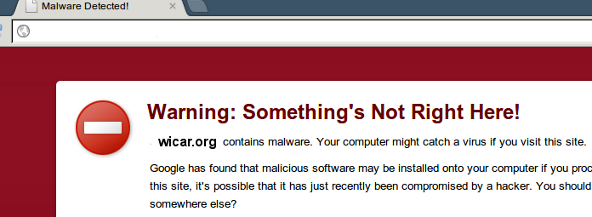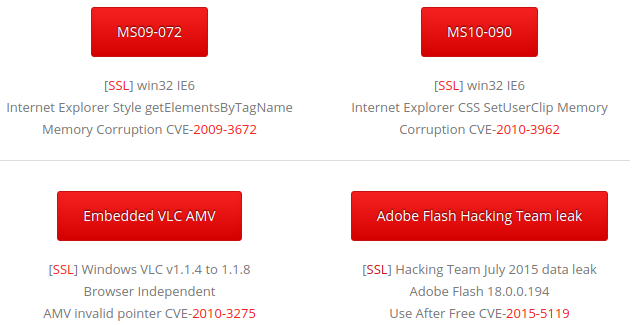|
The HTTP Strict-Transport-Security standard (HSTS) is a HTTP server header sent by SSL/TLS enabled websites to prevent communication over HTTP in order to protect content and authentication cookies from interception or alteration.
To enable this header on the nginx web server, modify the nginx.conf file. Within the server block, find and edit the location block and set the "add_header" directive with a value of e.g. Strict-Transport-Security "max-age=31536000"; (for 365 days). E.g: server { location / { add_header Strict-Transport-Security "max-age=31536000"; } } Many of you would have seen our anti-malware solution test website known as WICAR (think EICAR AV Test File, but for web based attacks). This is just a quick email to let you know we now have SSL enabled for our test malware attacks, so not only can you test your firewall, IDS/IPS, proxies, content filtering and desktop antivirus, but you can also check if you are protected against payloads delivered over HTTP/S or verify your SSL-inspection products are working.
Simply open the Test Malware page and click the [SSL] hyperlink to conduct the test over SSL to ensure your organisation is adequately protected (most attacks today are delivered over SSL to get around proxy inspection). To test a HTTP/S server for weak Diffie-Hellman (DH) SSL / TLS ciphers, you may use the following command (Linux):
$ openssl s_client -connect [target]:443 -cipher "EDH" EDH requires use of weak DH keys. If it connects, you may GET / HTTP/1.0 to confirm. A secure host should not connect, e.g. $ openssl s_client -connect www.gmail.com:443 -cipher "EDH" CONNECTED(00000003) 139671352862352:error:14077410:SSL routines:SSL23_GET_SERVER_HELLO:sslv3 alert handshake failure:s23_clnt.c:770: https://weakdh.org/ Introduction:
At some point you may be required to audit the configuration of a SonicWALL device. If you have physical/admin access to the management interface, then this is probably the easiest method - drill down every option and check for misconfiguration. If not, obtain a configuration export file (file name is generally 'sonicwall-name-date.exp') such as sonicwall-SydneyDC-20100607.exp. You will notice the file is a single line of Base64 encoding. Method: Either use software such as nipper (a tool to automatically decode multi-vendor firewall, router, switch etc.. configurations then analyse the settings and make recommendations in a pretty report) or Base64 decode it yourself and read the variables. Linux: 'base64 -d file' Windows (if you have ActiveState Perl): 'c:\bin\decode-base64.bat file' Recommendation: Often issues such as SSH v1 and SNMP will be present. Also check the firmware as SonicWALL is notorious for format string bugs. Introduction
Visit www.openspf.org for more information on this technology. Method It is held within a TXT record for the domain. You can query this with the host command under Linux/POSIX. $ host -t txt [victim].com [victim].com descriptive text "v=spf1 a mx include:[victim].com" Recommendation Consider adding SPF records to allow MX records to send email. SPF helps prevent forging of the FROM address on the receiver end. Customer MTAs which support SPF will reject fraudulent emails because the SPF record will not match the spammers IP source addresses when forging @[victim].com FROM addresses. Recently, a client of ours requested some information regarding security considerations should a corporation permit employees to use social media such as Facebook, YouTube, Twitter and other sites.
It is a common problem. There are a few issues here which need to be considered; 1) Yes there are cross-site scripting issues with the websites. But the vulnerabilities are in the websites themselves, so youtube.com, facebook.com and twitter.com are managed by internal staff - if they are vulnerable then everybody is. It is really out of your control. The worms use to propagate, such as the recent Facebook worm which was posting adult images, abuse the [zero-day] vulnerability in the website... eventually the sysadmins discover the worm and close the gap. 2) The web browsers also play a part in exploitability. Internet Explorer 8+ has some mitigations for XSS. Chrome and Firefox also have some anti-XSS measures, but still lack complete protection. NoScript add-ons can be used for Firefox and Chrome to further mitigate attacks. Earlier browsers such as IE6 and older releases of Firefox interpret HTML and JavaScript differently, as well as Content-Type / Content-Disposition which may make a user of IE6 vulnerable to a facebook worm but not say IE7. So up-to-date SOE browsers are a good idea depending on what your patching is like. 3) When using XSS attacks the attacker or worm often needs a location to store their malicious JavaScript. NoScript will deny external locations unless explicitly permitted. But regardless, attackers sometimes use what would be considered trusted websites... so it is possible for someone to obtain a Google Sites account, upload JavaScript, then the browser will fetch the content from *.google.com ... instead of a suspect .cn domain etc. 4) There is the crossdomain.xml policy - http://www.adobe.com/devnet/articles/crossdomain_policy_file_spec.html. This is dependent on the website. 5) Researchers occasionally uncover browser vulnerabilities which breach the internal browser cross-domain security policy... so the result may be a vulnerability despite proactive protections and hardened configuration. 6) Antivirus vendors such as TrendMicro provide browser add-ons which check and report all URLs accessed by clients world-wide. The Trend Micro Threat Intelligence cloud and other reputable AV companies will notice the worm after a handful of end-users report the malicious action of a site. In this case, a few users will be infected but after the cloud picks up on this, the URL will be blacklisted globally until the threat is eliminated, thus protecting end-users providing you're not the first few visitors to be infected. 7) Obviously if you have a HTTP AV / Content Filter proxy then this may detect some worms. So to summarise, there are many different preventative measures you can take to avoid infection. Implementing all of the above may significantly reduce your risk, but after all is said and done, if the youtube.com / facebook.com / twitter.com domains are vulnerable, you are waiting on them to provide a fix. If there is a known, unpatched worm spreading and the media has alerted users like the recent facebook adult photos and dead animals worm, you could temporarily ban access to those sites on the firewall until the worm is cleared to try and protect staff. Another matter worth considering is whether there is a risk of staff seeing objectionable material such as pornography from the worm and the staff going on stress leave, workers compensation or suing for psychological damages etc etc. Some organisations try to minimise law suits by implementing strict policies about what to do when someone sends you pornographic material and you unexpectedly open it. There is paper work to complete including who sent the email (they are permanently added to a blacklist), listing all who received the email, any 3rd parties that saw it on your screen, ensuring that email archive / data backup staff store the offending email if needed for court on tape, and email admin staff forcibly deleting copies from staff inboxes by conducting email audits. Hopefully this gives you some insight into corporate considerations prior to blanket access of social media websites for staff. Introduction
The web server has directory listings enabled, which may reveal folder contents that might otherwise be hidden from an attacker looking for sensitive information, Example URLs:
Recommendation: Modify the apache2.conf file and set the folder “Options” directive to -Indexes, so that directory indexing is disabled and restart the service. Risk: Low. Introduction
By default BIND DNS reveals the version number when queried for a certain TXT record. Command # dig chaos txt version.bind @ns.[target].com Result An example is below: ; <<>> DiG 9.7.1-P2 <<>> chaos txt version.bind @ns.[target].com ;; global options: +cmd ;; Got answer: ;; ->>HEADER<<- opcode: QUERY, status: NOERROR, id: 18628 ;; flags: qr aa rd; QUERY: 1, ANSWER: 1, AUTHORITY: 1, ADDITIONAL: 0 ;; WARNING: recursion requested but not available ;; QUESTION SECTION: ;version.bind. CH TXT ;; ANSWER SECTION: version.bind. 0 CH TXT "9.3.6-P1-RedHat-9.3.6-4.P1.el5" ;; AUTHORITY SECTION: version.bind. 0 CH NS version.bind. ;; Query time: 329 msec ;; SERVER: [ip]#53([ip]) ;; WHEN: Sat Aug 21 03:55:28 2010 ;; MSG SIZE rcvd: 87 Recommendation Using the 'version' directive in the 'options' section will block the 'version.bind' query - usually in /etc/named.conf. Intro
The server reveals its internal IP address when specifying a WebDAV PROPFIND request. Method Issue a PROPFIND request with a HTTP v1.1 empty Host header: telnet example.com 80 Trying 123.123.123.123... Connected to example.com. Escape character is '^]'. PROPFIND / HTTP/1.1 Host: HTTP/1.1 302 Redirect Content-Length: 140 Content-Type: text/html Location: / Server: Microsoft-IIS/6.0 Date: Tue, 08 Jun 2010 07:05:08 GMT Document Moved Object Moved This document may be found here Recommendation Reconfigure IIS to return the FQDN value instead: http://support.microsoft.com/kb/q218180/ Refs OSVDB 13431 Introduction
IIS + .NET may reveal sensitive information when an exception occurs. Often this information may include the system path to the webroot (i.e. C:\Inetpub\wwwroot) which may further aid in attacks where a malicious user may upload content, but is not sure where the file is located on the remote system. Method By requesting a document with an .ashx extention, the server reveals the path (e.g. D:\sites\secret\uploads). It also reveals the version of .NET in the footer, such as "Microsoft .NET Framework Version:1.1.4322.2407; ASP.NET Version:1.1.4322.2407". The Framework version can then be used to check for known vulnerabilities, such as NULL byte issues. Recommendation Within the Machine.config or Web.config file, specify a directive of "customErrors" of either "RemoteOnly" or "On". See also: http://msdn.microsoft.com/en-us/library/h0hfz6fc.aspx Introduction
The portal requires users submit a username and password to authenticate. This communication is not encrypted. Method Check the HTML source code on the form page, and examine whether the FORM ACTION is GET/POST to a HTTPS:// URI. Recommendation 1) Enable SSL and disable HTTP for the portal 2) Use two-factor tokens (one time password) for strong authentication. 3) Modify the HTML source to ensure the data is POST'ed to a HTTPS URL. 1.In Microsoft Windows, open Administrative Tools, and then click Internet Information Services (IIS) Manager.
IIS Manager appears. 2.Under Internet Information Services, expand Servername (local computer), expand Web Sites, right-click either Websitename or Default Website, and then click Properties. The Web Site Properties dialog box appears. 3.Click the Home Directory tab, and then click Configuration. The Application Configuration Settings dialog box appears. 4.Click the Debugging tab. 5.Change the radio button from "Send detailed ASP error messages to client" to "Send the following text error messages" and specify an error. |
Archives
September 2017
Categories
All
|
|
|
|




 RSS Feed
RSS Feed









